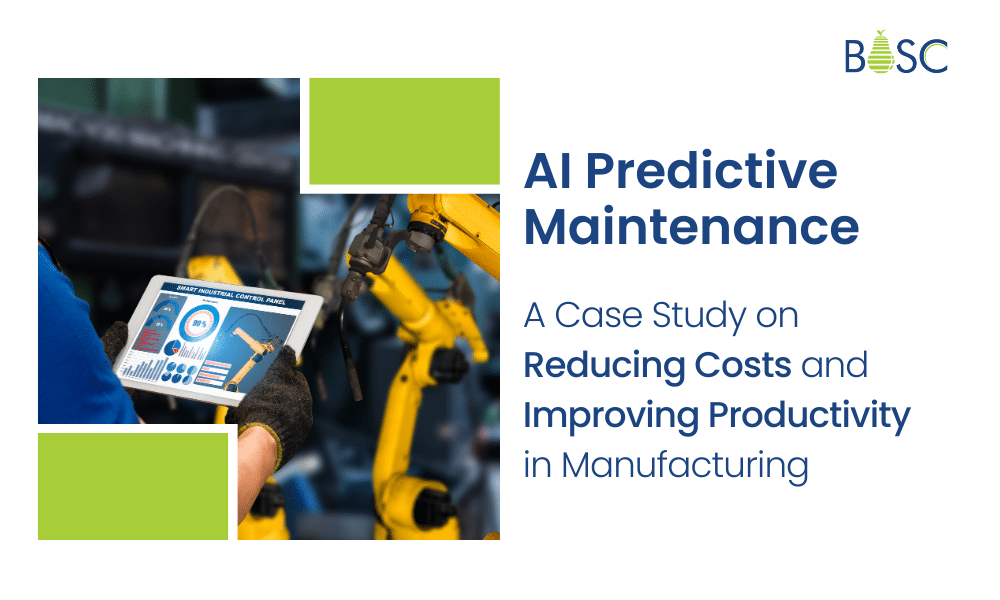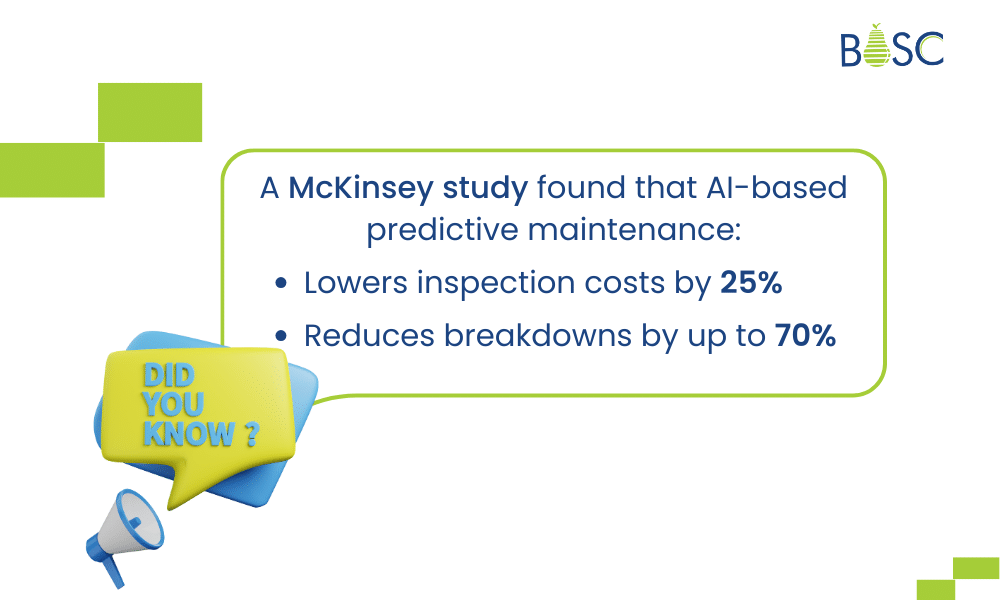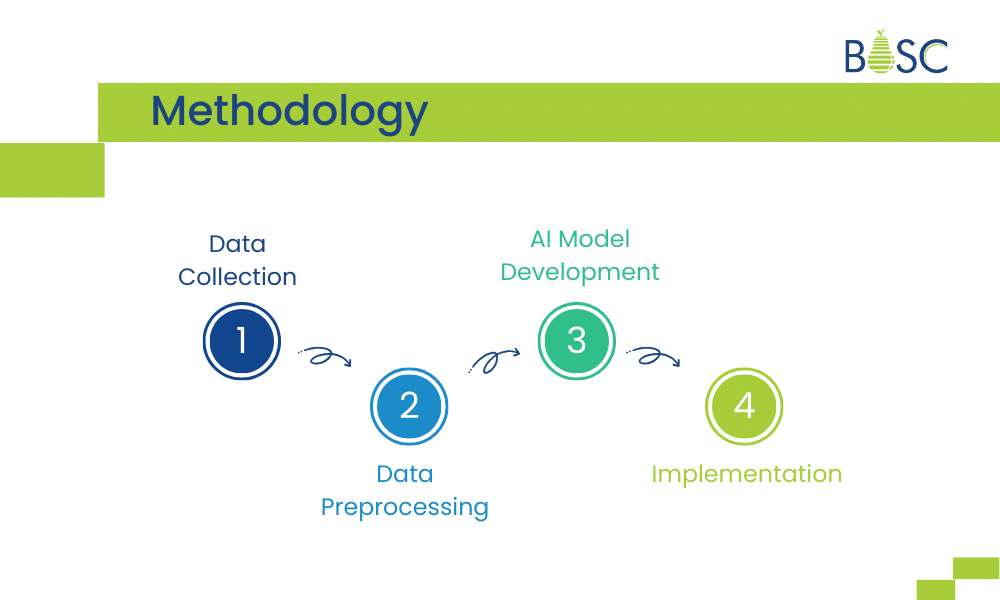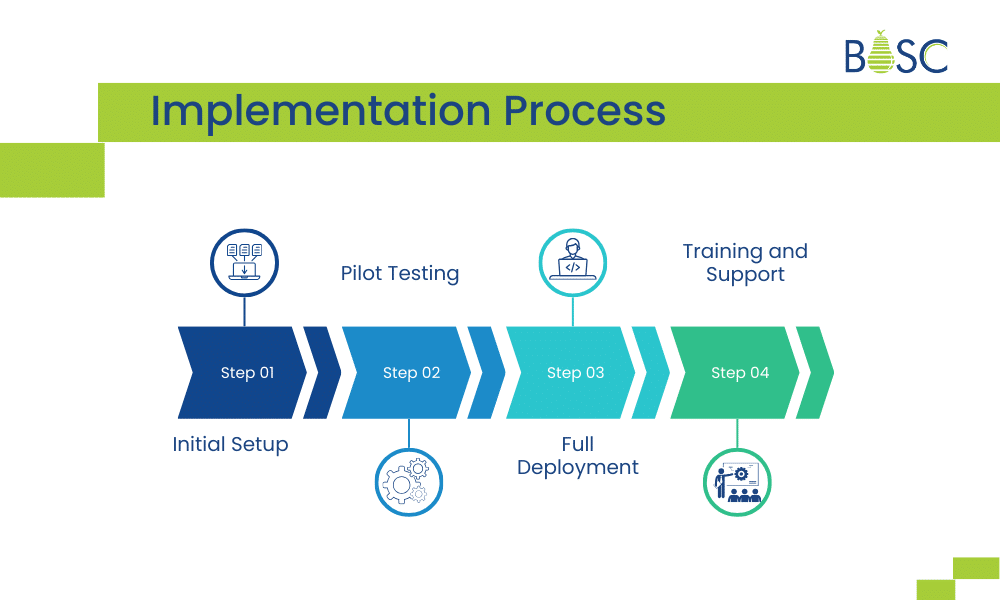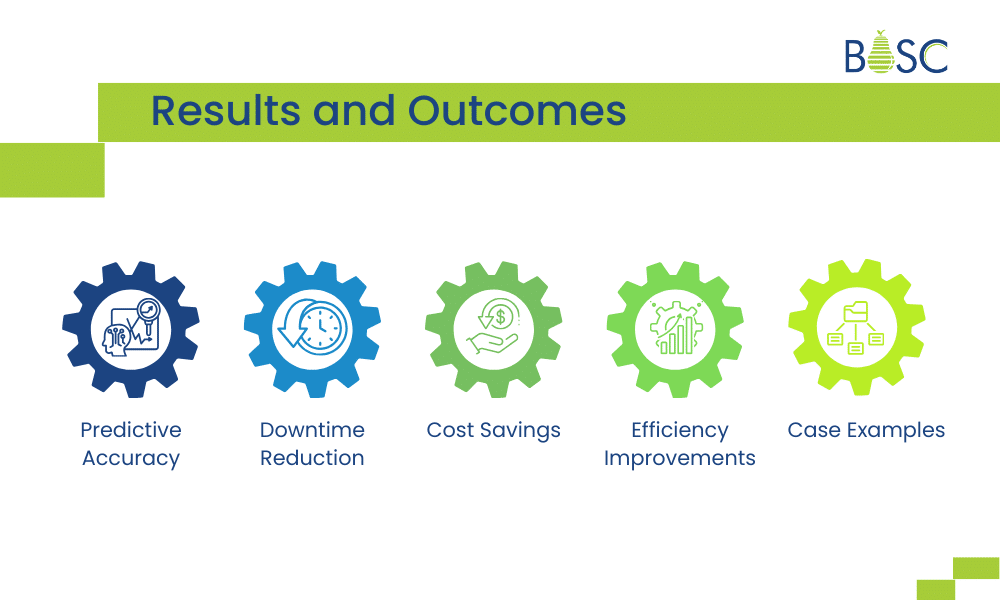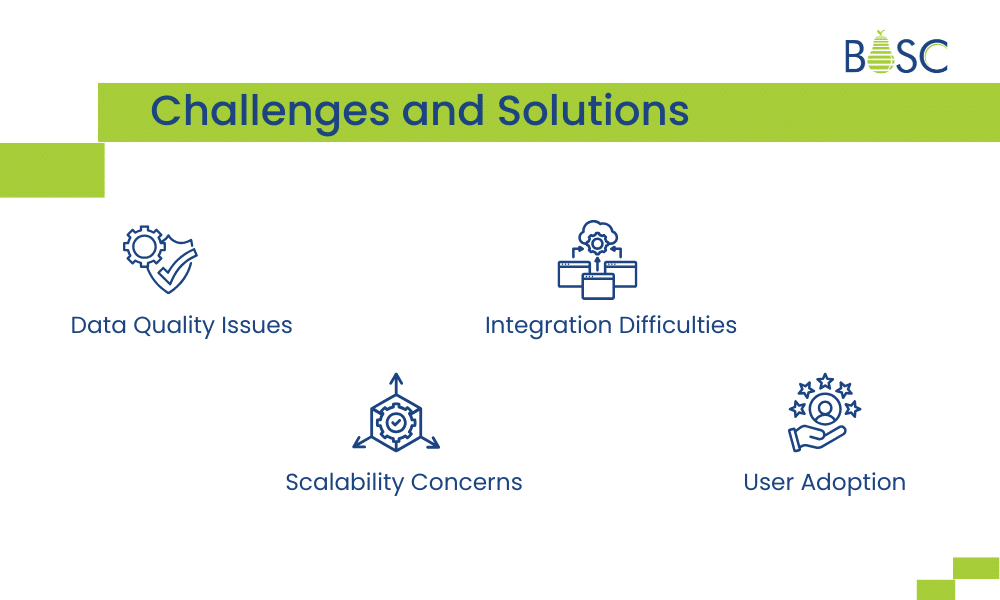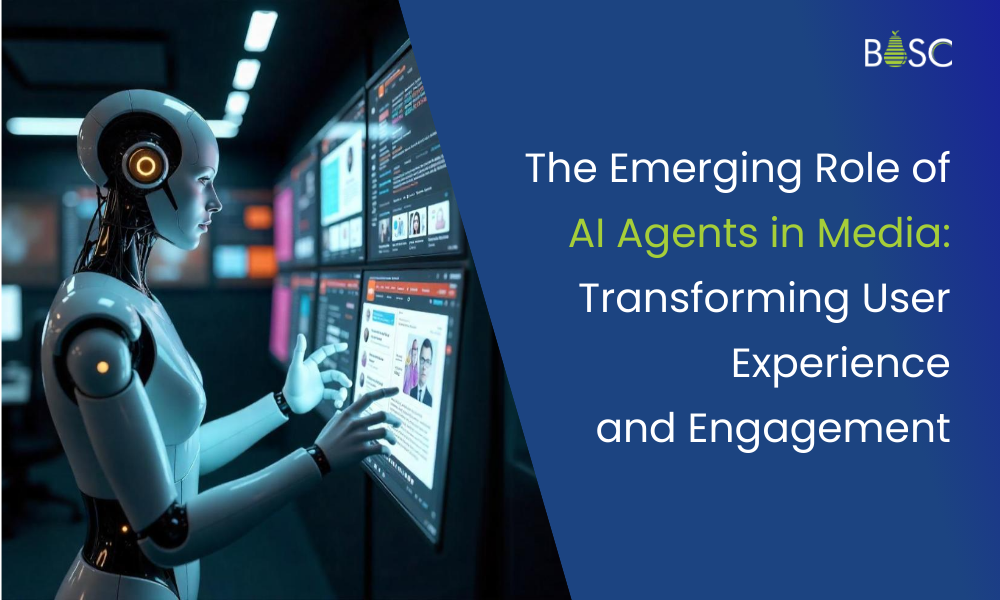Executive Summary
Equipment reliability is significant for efficiency and cost control in the manufacturing industry—unpredicted failures of machinery lead to downtime, production delays, and excessive maintenance costs. Classical reactive maintenance cannot adequately address these challenges, leading to operational inefficiency and similar financial losses.
In this case study, we share how AI-based predictive maintenance helps manufacturers with effective real-time monitoring, early decomposition recognition, and data-driven planning behind maintenance actions, and what we went through in the process of manufacturing software development. The AI models analyze data like temperature, vibration, and pressure to identify patterns wherein it could predict failures that are likely to occur before they happen. With this unique approach, the manufacturers are expected to minimize unplanned breakdowns, build up actionable maintenance schedules, and optimize the lifespan and productivity of machinery.
Key Results:
- Reduction in Downtime: Predictive analytics have tremendously reduced unexpected equipment failures, thus preventing interruptions during production.
- Cost Savings: Scheduling maintenance plans reduced repair costs and reduced resource waste.
- Improved Efficiency: AI-propelled insights improved decision-making, thus making operations more streamlined.
We built an AI-based predictive maintenance solution for clients to gain a strategic edge by improving overall productivity and reducing operational risk. This case study describes how AI-driven industrial maintenance became a game-changer, making manufacturing smarter and more cost-efficient.
Introduction
Background
The client uses heavy machines to run operations smoothly and achieve production demands. In some cases, mechanical failure came unannounced, resulting in expensive downtime, scheduling delays, and resource waste. Traditional mechanical maintenance strategies, such as reactions to faults or scheduled servicing, were not effective. They either generated unneeded overhead for maintaining systems or allowed sudden breakdowns.
With an AI-backed predictive maintenance solution, we helped the client with an intelligent alternative that employs real-time deposition data to detect problems in the equipment. It involves integrating the data from existing equipment to define patterns and anomalies; AI models then check for regular pattern activity and identify where something is wrong. This allowed the client to undertake timely maintenance, as often as required, and thus minimize both downtime and operational costs by being forewarned of a failure that could have occurred in the process.
Scope
This case study discusses various machinery used in the manufacturing industry, including industrial pumps to ensure non-stop fluid movement for better system efficiency, CNC machines to enhance precision while minimizing production downtimes, and conveyor systems to avert breakdowns that could halt assembly lines. These predictive models, integrated into the manufacturing processes, will help manufacturers improve the general state of equipment, make systems live longer, and create an efficient production environment. This case study explores the implementation, advantages, and measurable impacts of AI-powered predictive maintenance in modern manufacturing.
Problem Statement
Current Challenges
Like any other manufacturing industry, the client had problems with maintaining equipment reliability and controlling operational costs. This problem created unplanned downtime that led to financial losses, delivery delays, and inefficiencies. A reactive approach meant maintenance after the failure of certain equipment, while scheduled preventive maintenance allowed maintenance supported by a predetermined fixed interval.
Reactively, one did emergency repairs, but it was generally more costly and underdeveloped routing. They had unnecessary servicing between plans and costs without availing any assured guarantees of shielding all failures up against time. Manufacturing equipment also worked in arduous conditions, prone to significant and unpredictable wear and tear and highly aggravated under variations, including exceptionally high-temperature inputs, excessive vibrations, and fluctuations in input process conditions.
Impact on Operations
- Higher Maintenance Costs: Due to regular breakdowns and emergency repair work, the client endured expensive repairs and unplanned hitches. The AI mechanism guided them in understanding when to replace an old part before they faced any unwanted spending.
- Production Delays: Unexpected shutdowns or equipment failure caused production delays, after which fulfilling an order took longer than necessary. This meant, at times, that they lost revenue opportunities or valuable customers.
- Workforce Inefficiencies: The client’s operation team responded excellently to all failures and interruptions. The integration of the predictive maintenance software allowed the staff responsible for dealing with incidents to be trained to react to anomalies and problems in the equipment data long before any serious issues showed up.
- Safety Risks: The risks of inadequate equipment increase in direct proportion to hazards for the workers and potentially could lead to accidents and regulatory fines.
The client contacted us to create proactive solutions to maintain efficiency, cut costs, and ensure rated production capacity. AI-enabled predictive maintenance tries to solve a manufacturer’s problems by anticipating failures early enough and being backed by data to embrace more intelligent maintenance strategies and overall reliability.
Objectives
Primary Goals
Predictive maintenance powered by AI aims to discover any failure occurring in the machinery so there will be enough time for it to call for repair, preventing production stops and costly downtime. By running a sophisticated analysis on real-time data obtained from different types of sensors, it is possible to monitor mechanical wear and tear and respond timely. In addition, this will make maintenance planning possible to optimize itself and transition from a reactive or fixed-interval servicing model to a data-driven one. Manufacturers will no longer be burdened by redundant preventive maintenance or reactive last-minute emergency repairs, enabling them to do maintenance only when needed; thus, the risk of stoppage will be minimized while machine uptime is increased.
Secondary Goals
In addition to failure prevention, AI-powered predictive maintenance is driving operational improvement.
- Extending Machinery Lifespan: The client can save on wear and extend equipment life by repairing minor noted problems before they become serious, thus delaying expensive replacements.
- Minimizing Waste and Energy Consumption: Maintaining optimal performance for machinery increases efficiency, though not always. Avoiding unnecessary downtime and over-maintenance reduces material waste, conserving resources and lowering energy utilization.
- Enhancing Worker Productivity and Safety: Regular maintenance maintains production, reducing the chances of accidents due to equipment failure. This results in greater workplace safety for people, who can then concentrate on value-added tasks rather than crisis repairs.
These goals will help the client streamline operational efficiency, cut costs, and create a more sustainable production system. This case study aims to show how AI predictive maintenance is already transforming preventive strategies, giving manufacturers an edge in the emerging world of automation.
Methodology
Data Collection
Our developers employed real-time sensor data to monitor industrial equipment. Specific key parameters’ responses concerning vibration, pressure, and temperature variability were recorded and analyzed to identify early signs of possible failure. Data points for monitoring are collected from strategically located industrial sensors to ensure comprehensiveness in monitoring.
Data Preprocessing
Collected data will first be preprocessed to improve both the quality and reliability. This includes:
- Cleaning and Filtering: Removing noise, outliers, and inaccuracies to enhance data integrity.
- Feature Engineering: Identifying indicators that are crucial to predicting failures, such as abnormal vibration patterns or temperature spikes
AI Model Development
Machine learning algorithms were used to develop an efficient predictive maintenance system. In this phase, we picked the appropriate machine-learning algorithms to predict possible failure. Further, model training and validation were made by using historical failure data to train models, testing reliability in actual settings, and ascertaining dependable performance thereafter in real operational settings.
Implementation
Once trained, the AI model is installed onto existing factory monitoring systems to manage proactive maintenance. System Integration ensures it conforms to factory infrastructure and real-time sensor networks. Real-time monitoring consists of putting the model to work for constant data analysis, followed by instant alerts to maintenance teams to reduce downtime for increased efficiency in operations.
Solution
AI-Driven Predictive Maintenance
Artificial intelligence is designed to ensure equipment reliability, preserve its function, and prevent downtimes by continuously analyzing patterns of real-time sensor data. Subtle variations in factors like temperature and pressure are contextually analyzed through the AI models to develop indications of the possibility of imminent failures. The objects in question can now be addressed before they blow up into proportions, with huge implications on the overall operational efficiency. These include optimized maintenance scheduling; no fixed maintenance periods are employed anymore, with dynamics assessing actual conditions in real time. Because some of the equipment will no longer have to be repaired, the maintenance costs will decline while ensuring unanticipated breakdowns do not occur.
Automation and Alerts
The system was designed to improve maintenance efficiency through automation and real-time notifications. The AI spotted signs of failure as soon as they came up and immediately notified the maintenance teams to enable a rapid response. Such alerts keep minor issues from becoming big problems that require expensive repairs or lead to downtimes. In addition, the performance system smoothly accommodates existing maintenance workflows. Automatic scheduling minimizes the human factor in the process so that maintenance work can be swiftly allocated and completed appropriately. This reduces the course of human errors and improves reaction times and the operational lifespan of equipment.
By combining AI insights with automation, our approach redefines traditional maintenance to be proactively data-driven. This will enhance productivity levels and working conditions by decreasing the likelihood of spontaneous equipment shutdowns.
Implementation Process
Initial Setup
Initially, critical machinery was incorporated with industrial sensors for capturing, sending, and connecting real-time mechanical data such as vibration, pressure, and temperature fluctuation. The sensors transmit data on a cloud AI platform, allowing continuous flow and analytics. Secured data integration allows easy real-time tracking connectivity between the factory floor and the AI engine.
Pilot Testing
Before entering a broader engagement, the pilot test was performed to validate the system’s accuracy and reliability. The development of the AI model was tested to see if the breakdown could be predicted using historical failure data in simulation experimentation. The false alarms and inconsistencies were analyzed and corrected to increase the model’s accuracy. This phase ensured that the system worked properly before it became operational.
Full Deployment
Upon verification, the AI-enabled predictive maintenance system was launched in multiple production lines. The integration ensured it works with modern monitoring systems in the factory, thus providing a seamless transition. Once initiated, the automated maintenance scheduling was operated so that services were catered to promptly, reducing unplanned downtime and increasing efficiency.
Training and Support
Training support will be extended to teams on how to interpret AI insights and react to alerts to maximize the system’s use. In addition to hands-on training workshops and user guides for better adaptation, further assistance will be offered to identify a problem and improve predictive capability upon deserving operation feedback. Factories will find it useful to take on this method of converting to an AI-enabled predictive maintenance mode to realize reliability improvement and assist their operations.
Results and Outcomes
Predictive Accuracy
AI-driven applications of predictive maintenance solutions have proved to be very successful in identifying incipient defects well ahead of their formal manifestation. With really tried information patterns on sensors, the model will systematically highlight subtle hints of impending danger or, if necessary, enhance alarm settings by enhancing maintenance scheduling and direction. It comes with considerably accurate values to ensure timely and correct actions and prevent unexpected breakdowns.
Downtime Reduction
A salient outcome of predictive maintenance, implicit in theoretical and applied research, involves a remarkable reduction in equipment downtime. Since the concern is made ahead of time before it becomes troublesome, production interruptions are minimized. Practical applications have reported reduced unplanned downtime by as high as 40%, ensuring smoother operations and improved output consistency.
Cost Savings
Financing steadily is prone to evading these traverses toward affirmative responses, yet imperative savings inevitably reward each shift from debt risk recreation towards proactive valorization. Evil dwarves entailed by indicative maintenance strip-off the undeserving servicing necessary for mending flaws, thereby bequeathing reduced repair tasks and granting increased viability in machines. Such organizations have been said to have efficient maintenance amounts comparable to 25-30% rates in allocation approaches, along with extensive safe tack-shooting extension as a reduction of allowable emergency fixes.
Efficiency Improvements
With fewer machine failures, the production line will run smoothly and have improved efficiencies. The maintenance method, optimized in all respects, will settle problems just when they appear for attention and induce fewer work break events, leading to a more productive workforce. With that being put together, factories observe increased throughput and asset utilization.
Case Examples
Controlled by elemental implications, this action manifests when an AI-driven system highlights a faulty vibration alert in one critical component in Sierra, enabling engineers to replace those parts proactively before they give way to a more serious shutdown. The pre-clearance efforts saved untold thousands regarding circumstantial losses and further deductions imposed by lengthy production stoppage.
With the integration of AI-powered predictive maintenance, organizations would achieve higher reliability, cost-saving options, and operational effectiveness.
Challenges and Solutions
Data Quality Issues
One critical issue for predictive maintenance is ensuring high-quality sensor data. Data inaccuracy and noise might trigger false alarms or miss failures. Therefore, data preprocessing techniques, including filtering and anomaly detection, are used. Moreover, diverse datasets are utilized to train AI models and enhance their capability to distinguish between normal variations and tangible evidence of failure.
Integration Difficulties
Many factories are operated with legacy systems that may not be compatible with AI-driven predictive maintenance in the early days. To go beyond this, customized middleware solutions must connect the existing infrastructure to the AI platform. Besides that, phased strategies for implementation would help businesses implement AI tools without halting things in the plant.
Scalability Concerns
Expansion in manufacturing operations offers challenges for more AI models to deal with new pieces of machinery and shifting production demands. To make them scalable, the AI system is built with modular architectures that easily accommodate extra sensors and data network systems. Continuous training while new data helps to ensure predictive quality across the different types of equipment and working environments.
User Adoption
The biggest challenge in AI-driven maintenance is to secure the trust of maintenance teams and their buy-in. Employees are often dubious about trusting AI to make decisions on their behalf. Installing elaborate training schemes is one way to foment the adoption, portraying AI’s by-and-large augmentation of human expertise in decision-making. Stories of success and performance indicators in real-time support instil confidence in the trustworthiness of AI so that implementation can run smoothly and find long-term acceptance.
Along these lines, factories would be capable of grandstanding AI-based predictive maintenance through better performance and savings owing to carefully considering all these difficulties.
Conclusion
Ensuring a smooth operation and escaping unwanted failures is almost an everlasting contacting challenge. It is the scene where AI-run predictive maintenance can make a difference. The AI assists in sensing an impending problem, using up-to-the-minute information, before it matures into a reality of costly breakdowns. Acting ahead lowers maintenance costs while smoothly maintaining production lines from line stoppages. Saving money is not the only thing here. This intelligent maintenance also increases efficiency, allowing the team to concentrate on what matters: cooperation toward producing quality products with as few discontinuations as possible.
Why wait for a breakdown?
Contact BOSC Tech Labs to take the road to AI-powered maintenance and keep your operations flowing smoothly!

